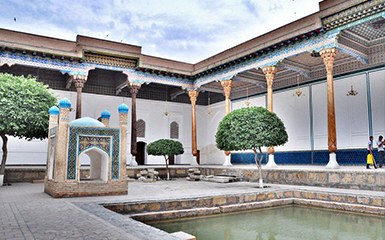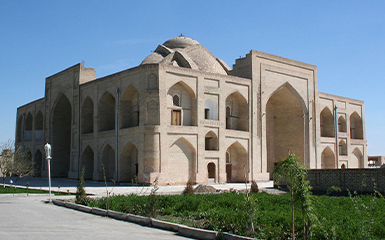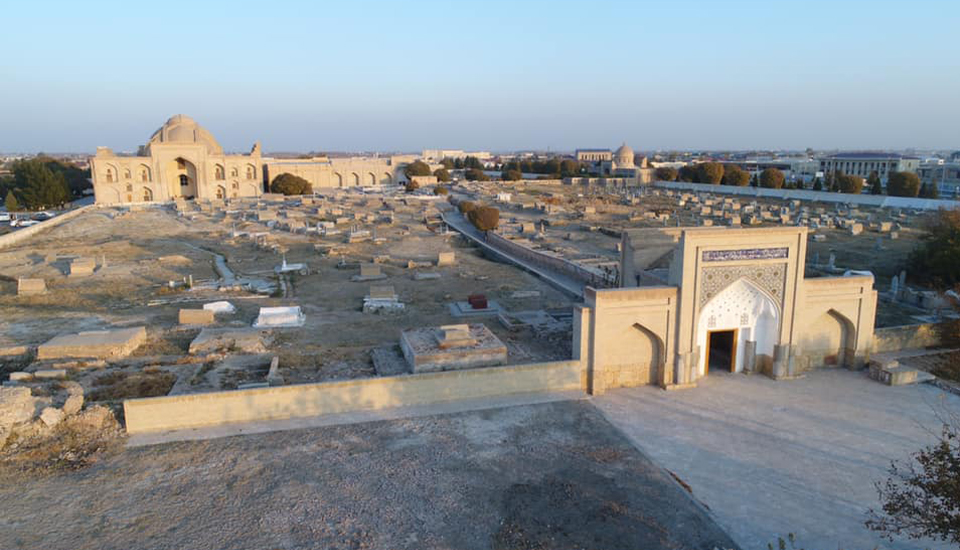Bahauddin complex
Char Minar
Lyab-I Hauz complex
Poi Kalan complex
The Ark Citadel
Bolo Haouz Mosque
Kalan Minaret
Islam Khodja complex
Itchan Kala
Kalta Minaret
Kunya Ark
Kutlugmurat Anak
Alla Kuli Khan
Muhammad Rahim Khan
Muhammed Emin Khan
Pahlawan Mahmud
Tash Hauli
Juma Mosque
Andijan
Muynak
Rabati Malik
The Bahauddin complex is an ensemble near the tomb of Sheikh Bahauddin Naqshbandi (Bukhara region, 16th century). The Bahauddin complex consists of huts (Dakhmai Shah and Bahauddin hut), a mausoleum, 2 mosques, a sanctuary, a pool, a well, a minaret, a madrasa and the Abdulaziz Khan khanaqah.
The complex begins with a small domed quarterback gatehouse. It is known that after passing through the gate, there was a small mosque on the right and various buildings for pilgrims on the left. Along the road to the left is the tomb of the khans - King Dakhmai.
The Dakhmai Shah is rectangular in shape, 2.5 m high, and covered with gray marble. It has excellent examples of marble carving and calligraphy. Marbles are carved with shelves, pillars, crowns, cypresses, and other ornaments; patterns are sometimes mixed with inscriptions. The corridor through the Dakhmai Shah leads to an elegantly decorated roof (the two-tiered door is decorated with "Baghdadi" and "Guli Nav" patterns).
After passing through the roof door, there is a domed mausoleum on the right (it is unknown who buried it). On the left - at the entrance there is a 6-storey (simply) Muzaffar Khan Mosque with a front porch. Next to the mosque there is a 2-column Hakim Kushbegi mosque (there is a magnificent sculpture in the altar of the mosque). It has patterned awnings on the south and patternless awnings on the north. The Bahauddin shrine is a large marble-covered platform with a beautiful marble fence. Not far from it, in the north, there is a marble pool with a circular staircase of 9.5 m on the sides, and on the north side there is a small, beautiful terrace. There is a well between the Bahauddin's shrine and the pool, and from the beautiful shed next to it, in ancient times, pilgrims were given "holy" water in various containers.
The mother of the ruler Abulfayz Khan (1711-1747) at her own expense ordered the construction of a mosque with two aivans (terraces), and in the 19th century, the vizier of Nasrullah Khan Hakim Kushbegi built another mosque. The minaret (tower) was built in 1720.
After Uzbekistan gained independence in honour of the 675th anniversary of Bahauddin Naqshbandi in 1993, the shrine was restored. Great work was done to improve the complex. A darvazakhana (entrance room) with a high dome was built. Richly decorated ayvans - terraces were recreated. The vast garden united into a single composition the sacred burial of Hazrat Bahauddin and the burial place of his mother. The Dakhmai Shokhon (Necropolis of rulers) was also restored, where the remains of some rulers from the Timurid, Sheibanid, Ashtarkhanid and Mangyt dynasties are buried.


